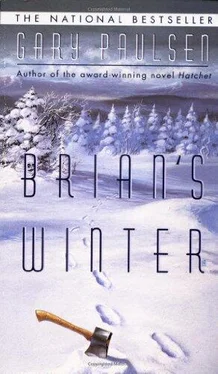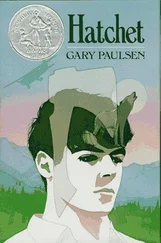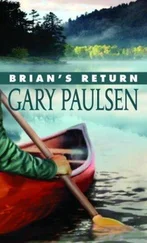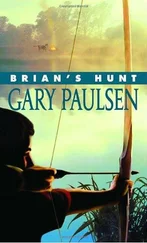In the morning he found that the damage was not as extreme as he’d thought. The bear had tipped the wall away and down but the dried mud had held it together and Brian — after four heaving tries — tipped it back up and against the rock. He chopped a hole in the thin ice near the edge of the lake and brought up new mud to pack in around the seam and inside an hour it was as good as new.
Then he reviewed his thinking. The war bow wouldn’t help — at least not as a protective device. He’d shot it and made it work for him but in the dark, in the night in the shelter, there was no way he could have gotten the bow aligned or an arrow into the bear. And god knew what would have happened if he had hit the bear with an arrow — especially if he’d missed anything vital. The bear would have been really mad then — even Betty wouldn’t have been able to stop the thing.
Perhaps, he thought, a lance — a killing lance. If he used the same principle as with the arrows…
He went back to the stone he’d been chipping arrowheads from and studied it. He would need a wider, longer head, and the flakes came off too small for a spear. Near it there were other black stones, however, and he tapped at them with the back of the hatchet, knocking off flakes until he hit one that had a bigger pattern. Three times he hit, and took off flakes that were irregular or that broke in the middle. But on the fourth try he came away with a piece almost as wide as his palm and about seven inches long, tapering to a sharp point and with two edges like razors.
He worked tie-notches into the round end and mounted the point in one of his hardwood spears, carefully splitting the wood back and then tying the head in place with a thin strip of deer hide — which proved to be much tougher than the rabbit skin — and burning the hair off when he was done.
He hefted the lance and held it out, bracing with his arm. It wouldn’t do any good to throw, but for in close, like last night — if he had to use it — the head should cause some damage. Or at least discourage a bear. He nodded. Good. If nothing else, it gave him a feeling of security.
Later he would think on how strange things were. He would never see the bear again and inside the shelter he would never be threatened again.
Yet the lance would save his life.
He awakened when he had slept enough, and looked out of the shelter by cracking the door. It was cold and low and gray and raining, a dismal rain much like the one that had lasted so long earlier in the fall, and he kindled the fire with dry wood he’d set aside the night before when he’d seen the clouds moving in. Soon the inside of the shelter was cheery and warm, the smoke working its way out of the hole at the top, and he wished he’d thought to bring water in the night before and also wished he didn’t have to do what he had to do now.
But he couldn’t fight it and at last he pulled himself out of the bag, grabbed the hatchet and the largest aluminum pot and plunged out into the rain. As fast as possible, standing barefoot on the freezing, wet ground, he went to the bathroom and then ran to the lake and chopped his watering hole open — it had frozen thinly overnight — and filled the pan and ran back to the shelter.
He slid the door back in place and put the pot on the fire and dropped a piece of venison into it to make a breakfast stew.
The meat was getting low. He had stretched the wolf-killed doe as far as he could, trying to ration it and eat smaller amounts, but he’d have to hunt within four or five days.
He put a piece of meat outside the door for Betty, surprised that she wasn’t there already, and leaned back to think.
In the past few days it had become colder. The weather had a kind of steady feel to it, as if it was not going to get warmer but would stay cold, and he had to face some truths.
He simply wasn’t ready for cold weather. Oh, he thought, the shelter was all right. And the woods were full of fuel.
But his clothing was pitiful. His jeans were holding together — just — but his tennis shoes were about gone, his socks long since used to shreds, and on top all he had was a T-shirt (also nearly in pieces) and the rabbit-skin vest.
I am, he thought, a mess. He was tempted to smile except that it wasn’t really funny. He could sit in the shelter and stay warm but unless he could hunt he would die and he couldn’t hunt unless he had something to wear to keep from freezing.
To death, he thought, the truth sliding in like a snake. I could freeze to death. Not quite yet — it wasn’t that cold yet — but soon. He didn’t know northern winters but he knew it would get cold enough to kill him and freeze him solid.
He took stock again. No clothing, although he still had some rabbit hides, which he could sew into sleeves for his vest. There was also the hide from the doe. He looked at it and thought that he might get a pair of moccasins out of it. They would be crude but if he stitched them with the hair on the inside and made them big enough to wear over his tattered tennis shoes they would help.
He set to work on what he could do and spent all of that day sewing the rest of the rabbit skins into two tubes, which he attached as sleeves to the vest. When he tried it on everything crackled, as if he were wearing paper, but it seemed to hold together and he slept that night feeling slightly better about his future.
The next morning he checked the weather — still raining, and colder than it had been the previous morning — and then set to work making footgear.
It proved both easier and harder than he had thought it would be. The easy part was making a pattern. He just stood on the dry skin and marked around his foot with a piece of charcoal from the fire pit. When he’d cut out the two bottoms he cut two rectangles from the remaining hide and stitched — with some effort as the hide was thick and tough — the two pieces into rough cylinders. Then he sewed each of the tubes down to the sole, attaching it all around the edge, and when he was done he had two clunky boots that he could stick his tennis shoes down into; with the hair on the inside they felt warm the minute he stuck his feet into them. He used the last bits of hide to cut two strips to use for lacing to pull the tops of the cylinders tight to his legs — they hit about midcalf — and it was here he learned how to soften leather.
The deer hide was dried and working with it was about like working with thin wood. It had no give and was brittle and hard and very, very tough. It was all he could do to sew the cylinders to the bottom using thin-cut hide for lacing and punching holes with the tip of the knife. But the two straps that went around the top had to be soft enough to tie off. He thought of using the fishing line for thread but didn’t want to waste it. Then he found that by working the leather — first between his fingers and then by pulling it over a piece of wood that stuck out of the wall — he could soften it. It never got truly soft and supple like tanned deer hide, but it was workable and got the job done.
He gathered more wood just before dark and went to sleep that night dreaming of punching holes in leather with the tip of the knife — the image burned into his mind from sitting all day sewing.
Sometime that night, near the middle, it grew quiet and the change awakened him. He listened for a time and realized that the rain had stopped and he snuggled back in the bag thinking that with no rain the next day he would hunt.
In the morning he awakened and knew instantly that something had changed. Something about the sound. No. The lack of it. There was no sound. Normally he could hear birds in the morning, or the wind rustling.
Читать дальше











